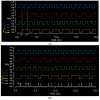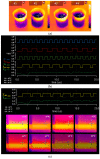The Design of an Automatic Temperature Compensation System through Smart Heat Comparison/Judgment and Control for Stable Thermal Treatment in Hyperthermic Intraperitoneal Chemotherapy (HIPEC) Surgery
- PMID: 37571507
- PMCID: PMC10422214
- DOI: 10.3390/s23156722
The Design of an Automatic Temperature Compensation System through Smart Heat Comparison/Judgment and Control for Stable Thermal Treatment in Hyperthermic Intraperitoneal Chemotherapy (HIPEC) Surgery
Abstract
After surgery for ovarian cancer or colorectal cancer, residual tumors are left around. A practical way to treat residual tumors is to destroy them with heat by injecting high-temperature drugs into the abdominal cavity. The injected medicinal substances are induced to flow out of the abdominal cavity; then, the spilled drug flows back into the abdominal cavity through feedback. During this process, the heat starts to decrease; thus, the treatment performance reduces. To overcome this problem, this study compares and assesses the temperature needed to maintain the heat for treatment and transmits a command signal to the heat exchanger through a look-up table (LUT). When the temperature decreases during the circulation of medications leaking out of the abdominal cavity, the LUT transmits a control signal (Tp) to the heat exchanger, which increases or vice versa. However, if the temperature (To) is within the treatment range, the LUT sends a Ts signal to the heat exchanger. This principle generates a pulse signal for the temperature difference (Tdif) in TC by comparing and determining the temperature (To) of the substance flowing out of the abdominal cavity with the reference temperature (Tref) through the temperature comparator (TC). At this time, if the signal is 41 °C or less, the LUT generates (heats) a Tp signal so that the temperature of the heat exchanger can be maintained in the range of 41 °C to 43 °C. If the Tdif is 44 °C or higher, the LUT generates (cools) the Ta signal and maintains the temperature of the heat exchanger at 41-43 °C. If the Tdif is maintained at 41-43 °C, the LUT generates a Tx signal to stop the system performance. At this time, the TC operation performance and Tdif generation process for comparing and determining the signal of To and Tref for drugs leaking out of the abdominal cavity is very important. It was observed that the faster the response signal, the lower the comparison and judgment error was; therefore, the response signal was confirmed to be 0.209 μs. The proposed method can guarantee rapid/accurate/safe treatment and automatically induce temperature adjustment; thus, it could be applied to the field of surgery.
Keywords: HIPEC surgery; LUT; cancer; high-temperature drug; temperature adjustment.
Conflict of interest statement
The authors declare no conflict of interest.
Figures














Similar articles
-
Comparative Sensing and Judgment Control System for Temperature Maintenance for Optimal Treatment in Hyperthermic Intraperitoneal Chemotherapy Surgery.Sensors (Basel). 2024 Jan 17;24(2):596. doi: 10.3390/s24020596. Sensors (Basel). 2024. PMID: 38257692 Free PMC article.
-
The Temperature-Dependent Effectiveness of Platinum-Based Drugs Mitomycin-C and 5-FU during Hyperthermic Intraperitoneal Chemotherapy (HIPEC) in Colorectal Cancer Cell Lines.Cells. 2020 Jul 25;9(8):1775. doi: 10.3390/cells9081775. Cells. 2020. PMID: 32722384 Free PMC article.
-
Intra-abdominal temperature distribution during consolidation hyperthermic intraperitoneal chemotherapy with carboplatin in the treatment of advanced stage ovarian carcinoma.Int J Hyperthermia. 2015 Jun;31(4):396-402. doi: 10.3109/02656736.2015.1007399. Epub 2015 Feb 24. Int J Hyperthermia. 2015. PMID: 25707816
-
Role of surgery and hyperthermic intraperitoneal chemotherapy in ovarian cancer.ESMO Open. 2021 Jun;6(3):100149. doi: 10.1016/j.esmoop.2021.100149. Epub 2021 May 10. ESMO Open. 2021. PMID: 33984680 Free PMC article. Review.
-
Hyperthermic Intraperitoneal Chemotherapy (HIPEC): An Overview of the Molecular and Cellular Mechanisms of Actions and Effects on Epithelial Ovarian Cancers.Int J Mol Sci. 2022 Sep 3;23(17):10078. doi: 10.3390/ijms231710078. Int J Mol Sci. 2022. PMID: 36077477 Free PMC article. Review.
References
-
- Shin H.Y., Kim J., Lee S., Park M.S., Park S., Bak S.M., Seo H., Statistics Korea Vital Statistics Division Cause-of-death statistics in 2018 in the Republic of Korea. J. Korean Med. Assoc. 2020;63:286–297.
-
- Yoon K., Chung J.-W., Kim K.G. A Metal Detector for Clip Location Tracking of Stomach and Colon Cancer during Laparoscopic Surgery. Appl. Sci. 2022;12:7330. doi: 10.3390/app12147330. - DOI
MeSH terms
Grants and funding
LinkOut - more resources
Full Text Sources

